Physical Address
304 North Cardinal St.
Dorchester Center, MA 02124
Brushing cytology and fine-needle aspiration (FNA) are used to sample lesions in the biliary tract and pancreas. Endobiliary brushing is currently the preferred method of sampling the pancreatobiliary system in patients with a stricture or obstruction without an associated mass. It is also used to screen patients with primary sclerosing cholangitis (PSC). FNA is the most effective procedure for sampling solid and cystic masses of the pancreatobiliary tract.
The primary challenge for the pathologist in pancreatobiliary cytology specimens is the distinction of benign and reactive processes from adenocarcinoma. Other challenges include the diagnosis of nonductal neoplasms of the pancreas, the identification of subtypes of ductal adenocarcinoma, and the diagnosis of metastases. This chapter reviews the cytomorphology of the biliary tract and pancreas and discusses cytological differential diagnoses and the application of ancillary studies.
Guidance methods for endobiliary brushing include endoscopy, endoscopic retrograde cholangiopancreatography (ERCP), and percutaneous transhepatic cholangiopancreatography (PTC). Guidance techniques for FNA include intraoperative palpation and direct visualization, transabdominal ultrasound (TUS), intraoperative ultrasound, computed tomography (CT), and endoscopic ultrasound (EUS). EUS has become the preferred imaging technique at many academic centers and large community hospitals. Briefly, a biopsy needle is passed through the biopsy chamber of an echoendoscope, which consists of a linear array transducer mounted distal to the end of the viewing optical component of the endoscope. The needle is passed through either the duodenum, or stomach, into the pancreatobiliary mass, under real-time imaging.
Indications for sampling of the biliary and pancreatic ducts using brushing cytology include the presence of a stricture or obstruction. The biliary tree is also sampled using brushing cytology to monitor patients with primary sclerosing cholangitis (PSC) , who are at risk of developing cholangiocarcinoma. FNA is indicated for the sampling of solid or cystic masses of the pancreatobiliary tract.
Contraindications to brushing of the biliary tract or pancreatic ducts include the contraindications to the techniques used to guide ERCP and PTC. Absolute contraindications to ERCP include patient refusal to undergo the procedure; unstable cardiopulmonary, neurological, or cardiovascular status; and existing bowel perforation. Relative contraindications include structural abnormalities of the esophagus, stomach, or small intestine. PTC is contraindicated in patients with bleeding diatheses and significant ascites.
Contraindications to EUS-FNA include an uncorrectable bleeding disorder or lack of a safe needle access route. Gastrointestinal (GI) obstruction is an absolute contraindication for EUS-FNA because of the risk of intestinal perforation.
The role of rapid on-site evaluation (ROSE) is not clearly established for brushing cytology. However, if smears are going to be prepared on-site, then it is preferable that they be prepared by an experienced cytotechnologist or pathologist.
ROSE, performed by either a cytotechnologist or pathologist, is probably the single greatest factor responsible for improving the diagnostic accuracy of FNA for solid masses of the pancreatobiliary tract. ROSE of selected smears ensures specimen adequacy and reduces the number of inadequate specimens due to poor localization of the lesion, scant cellularity, obscuring blood, as well as poor sample preparation or preservation. Thus ROSE produces significant cost savings and may spare the patient additional procedures. ROSE also allows the interpreter to determine the need for adjunctive studies, such as flow cytometry, immunohistochemistry, or microbiology. ROSE is not indicated for purely cystic masses but can be performed on the solid component of a cystic mass.
Prospective and retrospective studies documented a higher level of sensitivity of biliary brushings over exfoliative cytology for the detection of biliary carcinomas. Duct brushing cytology has an overall sensitivity of 26% to 88.9%, a specificity of 80% to 100%, and an overall accuracy of 48.1% to 96%. In PSC, the sensitivity has been 60%, with a specificity of 89%. The sensitivity of bile duct brushings has been shown to increase after repeated attempts. , In fact, the probability of a patient having a carcinoma is less than 6% after three negative brushings. Predictors of positive yield include the presence of a true stricture, older age, mass size >1 cm, and stricture length of >1 cm. , The presence of stones correlates with benign cytology.
Most false negatives occur because of sampling error, , which may occur when the tumor does not invade biliary mucosa. In addition, tumors with sclerotic desmoplastic stroma do not exfoliate cells as readily as tumors without desmoplasia, and thus may not be detected with brushings. Poor visualization of the area by the endoscopist may negatively impact the sampling. Interpretation errors (17%) and technical errors (17%) are the second most frequent causes of false-negative results. Most interpretative errors result from underinterpretation of adenocarcinoma due to the difficulty of distinguishing adenocarcinoma from reactive changes. The converse is also true: reactive changes can mimic adenocarcinoma, and lead to false-positive results. Degeneration of malignant cells is also a source of false negatives. False positives commonly result from overinterpretation of reactive and degenerative changes or adenomatous epithelium from villous tumors of the ampulla or bile duct. Intraductal neoplasms and dysplasia within the biliary ductal system may also lead to false positives.
The reported sensitivity for percutaneous pancreatic FNA, with the use of a variety of guidance techniques, ranges from 45% to 97%. The specificity is nearly 100%. Diagnostic accuracy ranges from 75% to 100%. The low sensitivity and low negative predictor values are cited as major limitations of pancreatic fine-needle aspiration biopsy (FNA). However, in our experience, the sensitivity for a diagnosis of adenocarcinoma is greater than 90% when ROSE is performed to ensure specimen adequacy. The sensitivity for EUS-FNA ranges from 60% to 96%, with a specificity of nearly 100%.
Factors that affect the accuracy of the procedure include (1) accurate localization of the mass by the operator, (2) adequate sampling of the mass, (3) correct sample preparation, and (4) correct interpretation by the pathologist. Accurate localization and adequate sampling are highly dependent on the skill of the operator. The sample should be representative of the intended target and should contain a sufficient number of cells for proper interpretation. Certain lesions may not yield diagnostic material regardless of the skill of the operator. These include most cystic lesions and sclerotic, vascular, or necrotic tumors. Aspiration of the periphery of necrotic tumors may help obtain better-preserved material. Poor sample preparation also hinders accurate interpretation by the pathologist. Factors that affect interpretation include blood, air-drying artifact on smears intended for alcohol fixation, crush artifact, and smears that are spread too thick.
The traditional method is to prepare smears from the brushing and make both air-dried smears for on-site evaluation and alcohol fixed smears for Papanicolaou stains. The brush may also be collected in Cytolyt (Hologic, Marlborough, MA) and the sample prepared as a ThinPrep (Hologic, Marlborough, MA). Although the latter shows great sensitivity, another potential method involves vortex-mixing the brush and then cutting the sheath and guidewire into 5 cm pieces, vortex-mixing these separately, and preparing a cytospin. This procedure may significantly increase cellularity.
Preparation methods used for FNA samples include direct smears, cytospins (Thermo-Shandon Instruments), liquid-based preparations, such as ThinPrep (Cytyc Corporation, Marlborough, MA) or SurePath Prep (TriPath, Inc., Burlington, NC), and cellblocks. Guidelines for preparation of different sample types are as follows.
Current cyst fluid protocols include analysis of carcinoembryonic antigen (CEA) and amylase and molecular studies, in addition to cytology. Proper triage of the specimen is necessary to ensure that all necessary studies may be performed. The sample for the molecular studies should be submitted from the neat fluid (fluid before it is centrifuged); usually only 0.3 mL is required. CEA and amylase may be measured from the supernatant after the fluid is centrifuged. If the sample is insufficient, it may be diluted and then the final CEA and amylase values corrected by the dilution ratio. The cell pellet is used to prepare the cytology sample using either cytospins or other concentration technique and cell block.
Triage of pancreatic cyst fluid is volume dependent. Usually, with volumes greater than 1 mL, all of the studies can be performed. If the volume is 0.5 mL or less, triage will depend on the clinical question. If the question is whether the cyst is mucinous or nonmucinous, then priority should be given to CEA. If the question is whether it is a low- or high-grade lesion with a greater risk of malignancy, then DNA analysis should be given priority.
Some laboratories use ThinPrep to prepare their cyst fluids. A concern is that mucin may be attenuated using ThinPrep. At the Moffitt Cancer Center practice, we receive pancreatic cyst fluids prepared using ThinPrep and have noticed the mucin is retained.
FNA of solid masses may be assessed by ROSE. Typically, air-dried and alcohol-fixed smears are prepared from an aliquot of each pass sample and the remainder of the material in the needle and syringe is rinsed in a preservative for cell block. The air-dried smear is stained with Diff-Quik or other Romanowsky stain and the alcohol-fixed smear is stained with Papanicolaou. There are a number of alternative staining methods for ROSE, which are beyond the scope of this chapter.
The Papanicolaou Society of Cytopathology terminology system for reporting pancreatobiliary cytology specimens (PSCSRPBC) is a standardized terminology scheme for reporting pancreatobiliary specimens that includes diagnostic criteria. The PSCSRPBC created six reporting categories: Nondiagnostic, Negative (for malignancy), Atypical, Neoplastic, Suspicious (for malignancy), and Positive/Malignant. These categories are for use in laboratories where the information system requires a diagnostic category for reporting cytology specimens; otherwise samples may be reported with only a diagnosis line.
Correlation of cytology findings with clinical, imaging, and ancillary findings is required to determine sample adequacy. If a sample does not meet adequacy criteria, it is categorized as nondiagnostic. Adequacy criteria are summarized in Box 36.1 . The term nondiagnostic is preferred to unsatisfactory because unsatisfactor y implies that the sample could not be evaluated microscopically.
Preparation artifact or obscuring artifact precludes evaluation of the cellular component
Gastrointestinal epithelium only
Normal pancreatic tissue in the setting of a clearly defined solid or cystic mass by imaging
Acellular aspirates of a solid mass or pancreatobiliary brushing
Acellular aspirate of a cyst without evidence of a mucinous etiology
The negative category is used when the sample is representative of a nonneoplastic process, such as acute or chronic pancreatitis ( Table 36.1 ). The atypical and suspicious categories are both indeterminate categories, and criteria for these are summarized in Boxes 36.2 and 36.3 , respectively. In general terms, these categories are used when the sample shows abnormal cells, which cannot be classified as definitely benign or definitely malignant, because of either a scant number of representative cells or artifact precluding evaluation. These categories should be used sparingly. The positive/malignant category is used for samples with high-grade and aggressive neoplasms, such as ductal adenocarcinoma (see Table 36.1 ).
| Category | Diagnostic Entity |
|---|---|
| Negative | Acute pancreatitis Chronic pancreatitis Autoimmune pancreatitis Para duodenal pancreatitis Ectopic spleen Lymphoepithelial cyst Pseudocyst |
| Neoplastic: Benign | Serous cystadenoma Lymphangioma |
| Neoplastic: Other | Intraductal papillary mucinous neoplasm Mucinous cystic neoplasm Pancreatic neuroendocrine tumor Solid pseudopapillary neoplasm |
| Positive/Malignant | Adenocarcinoma Lymphoma Sarcoma Metastatic malignancies Neuroendocrine carcinoma Acinar cell carcinoma |
Atypia is not clearly recognized as benign/reactive, less than that considered sufficient for suspicious.
Mild alteration of the honeycomb pattern in the epithelial sheets and nuclear crowding with minor degrees of nuclear overlapping are observed.
Cell balls with marked nuclear overlap obscuring underlying nuclei are not seen and true nuclear molding is absent.
Nucleoli are often enlarged, but true macronucleoli are absent.
A near-normal nuclear cytoplasmic ratio is maintained.
Slight membrane irregularities are present.
Parachromatin clearing is observed without other features of adenocarcinoma such as nuclear membrane abnormalities, 4:1 anisonucleosis, and true “drunken honeycomb.”
The smear background is either clean or contains red blood cells.
Significant alterations in architectural and individual cell morphology are present that may be qualitatively or quantitatively insufficient for a definitive diagnosis of any type of malignancy.
Some, but not all features of adenocarcinoma are present, such as crowed groups and nuclear overlapping.
Hyper- or hypochromasia, irregular nuclear membranes, macronucleoli, increased nuclear-to-cytoplasmic ratio, and significant anisonucleosis (4:1) are present.
Tumor diathesis is highly suggestive of malignancy.
The neoplastic category is further subdivided into Neoplastic: Benign and Neoplastic: Other . Neoplastic: Benign includes benign neoplasms such as serous cystadenoma or lymphangioma. The Neoplastic: Other category includes neoplastic processes that are preinvasive precursor lesions for adenocarcinoma, such as mucinous cystic neoplasm (MCN) and intraductal papillary mucinous neoplasm (IPMN), with low- and high-grade dysplasia. Pancreatic neuroendocrine tumor (PanNET) is included under the Neoplastic: Other category but this decision remains controversial. It is recognized that PanNET > 0.5 cm have malignant potential. The decision to categorize them as Neoplastic: Other was the fact that some PanNET in elderly patients with comorbid conditions may be managed expectantly and to maintain the classification consistent with the term “tumor.” Solid pseudopapillary neoplasm is also categorized as Neoplastic: Other. The categories and corresponding diagnostic entities are listed in Table 36.1 .
Any cyst classified as mucinous, based on the presence of background mucin, CEA levels, or KRAS or GNAS mutations is categorized as Neoplastic: Other. A key caveat is that it is never acceptable to interpret the cytology of a pancreatic cyst as consistent with cyst contents.
Contaminants from the duodenum may occasionally be seen with ERCP-guided brushing cytology of the pancreatobiliary tree and contaminants from other sites may be obtained with FNA of either the biliary tract or pancreas ( Box 36.4 ).
Round nuclei, even chromatin
Flat, evenly spaced sheets, sometimes folded over
Intracytoplasmic windows
Polygonal cells with well-defined, granular cytoplasm
Cells may occur singly; as small clusters; or as jagged, irregular groups
Round nuclei with small nucleoli
Cytoplasmic inclusions including fat, lipofuscin, bile
Flat, monolayered, honeycomb sheets or columnar cells on edge with basally located nuclei
Foveolar mucinous cells with mucin in upper two-thirds of cytoplasm or involving the entire cytoplasm
Stripped nuclei in a background of mucin
Parietal cells and chief cells
Flat sheets in a honeycomb pattern with distinct cytoplasmic borders or picket fence arrangement with basally located nuclei
Columnar enterocytes with microvillus brush border
Goblet cells
Paneth cells
Background mucin
Mesothelial cells are polygonal cells arranged in flat sheets and show round to oval nuclei and intercytoplasmic “windows” ( Fig. 36.1 ). They may be mistaken for benign ductal cells or squamous cells.
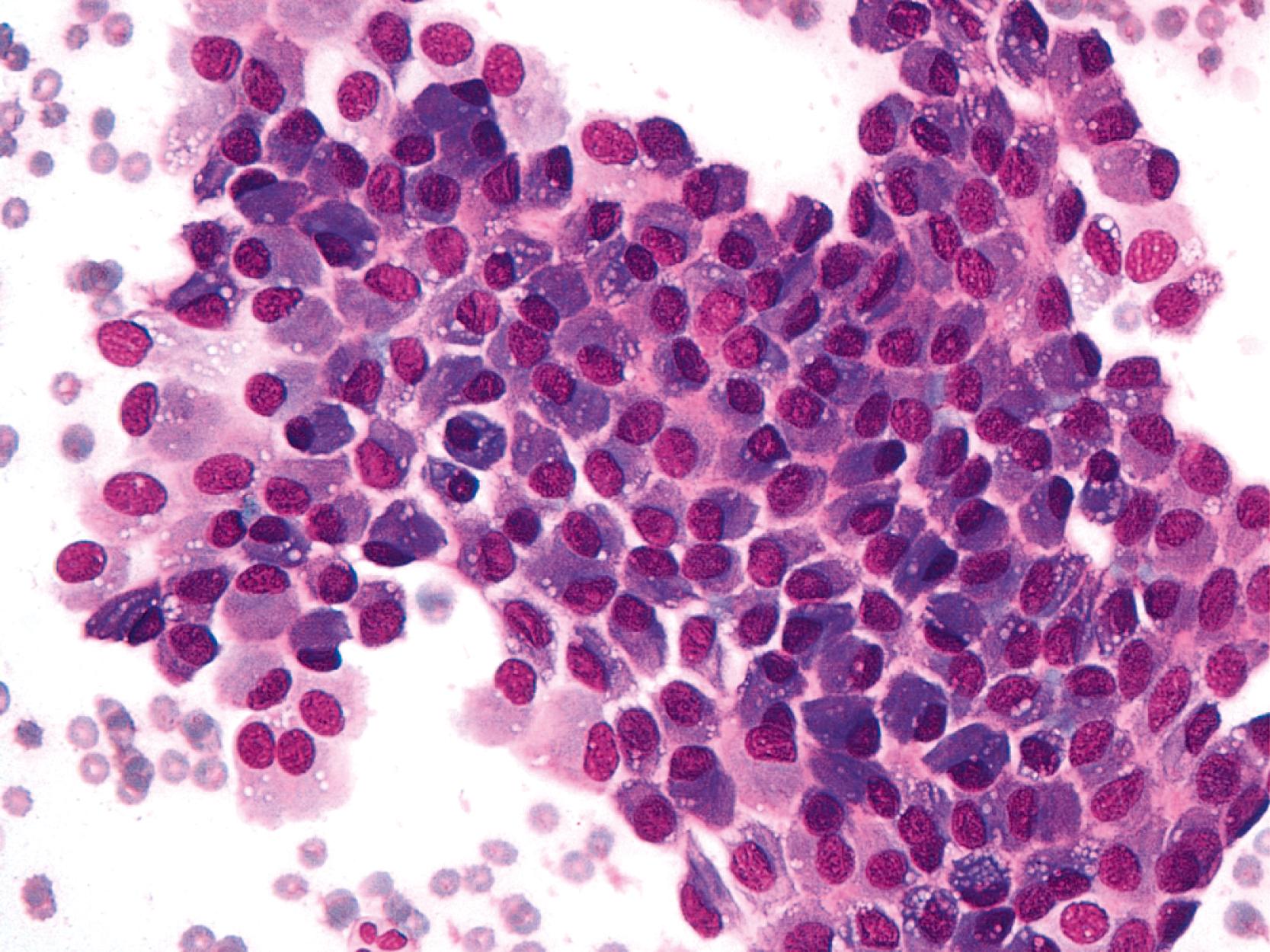
Normal hepatocytes are large polygonal cells with dense, sharply defined cytoplasmic borders and round, central, or eccentric nuclei with prominent nucleoli ( Fig. 36.2 ).
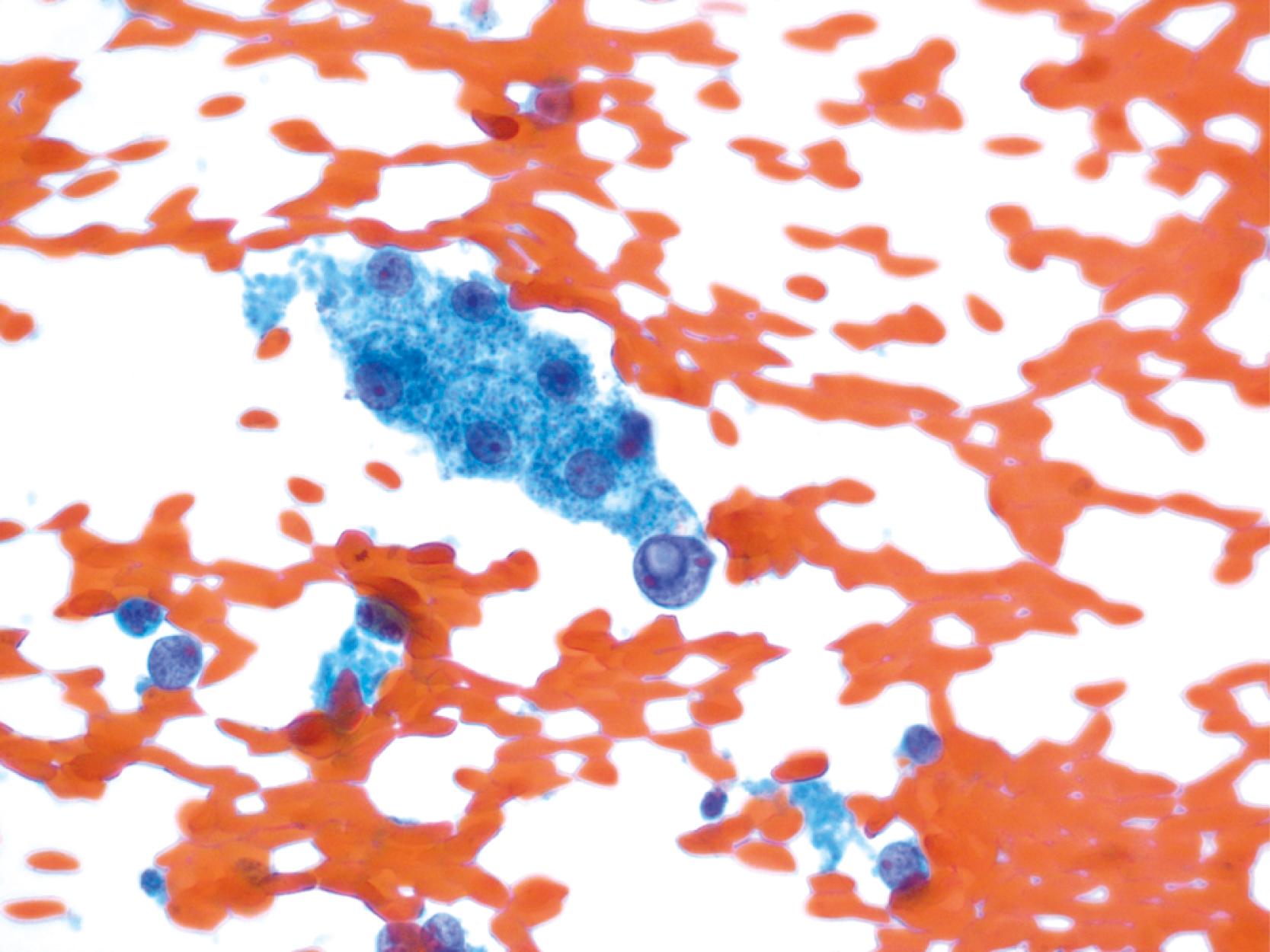
GI epithelium is a frequent contaminant in EUS-FNA samples.
The surface mucus cells of the gastric epithelium are columnar cells that are typically arranged in large folded sheets, with palisaded rows or single cells, usually associated with background mucin. Typically, a luminal border may be seen along one edge of the cellular aggregates. The sheets are typically monolayered, but occasionally may be folded or thick ( Fig. 36.3A,B ). The gastric pits may appear as rosettes in the center of a cellular sheet. The mucus glands of the cardia or pylorus are indistinguishable from the foveolar surface mucous cells. The cells derived from the foveolae and mucous glands display mucinous cytoplasm, often contained in the upper third of the cytoplasmic compartment ( Fig. 36.4 ), although the mucin may extend to the nucleus. Gastric epithelium may also appear as stripped, bland, slightly elongated nuclei within a background of mucin ( Fig. 36.5 ). , Chief and parietal cells may be noted if the needle traverses the gastric fundus or body ( Fig. 36.6 ). Intact fragments may show attachment of the surface epithelium to the lamina propria. Gastric epithelium is associated with abundant watery mucin that may contain degenerated cells if there is an inflammatory process.
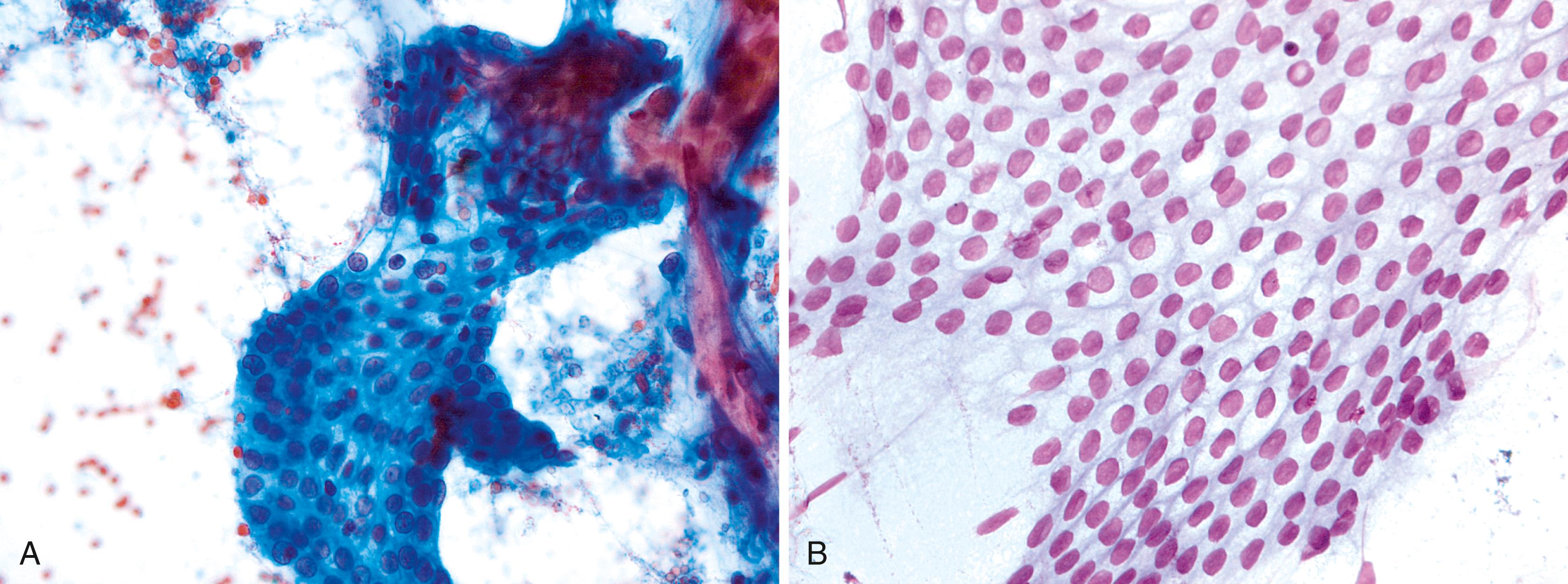
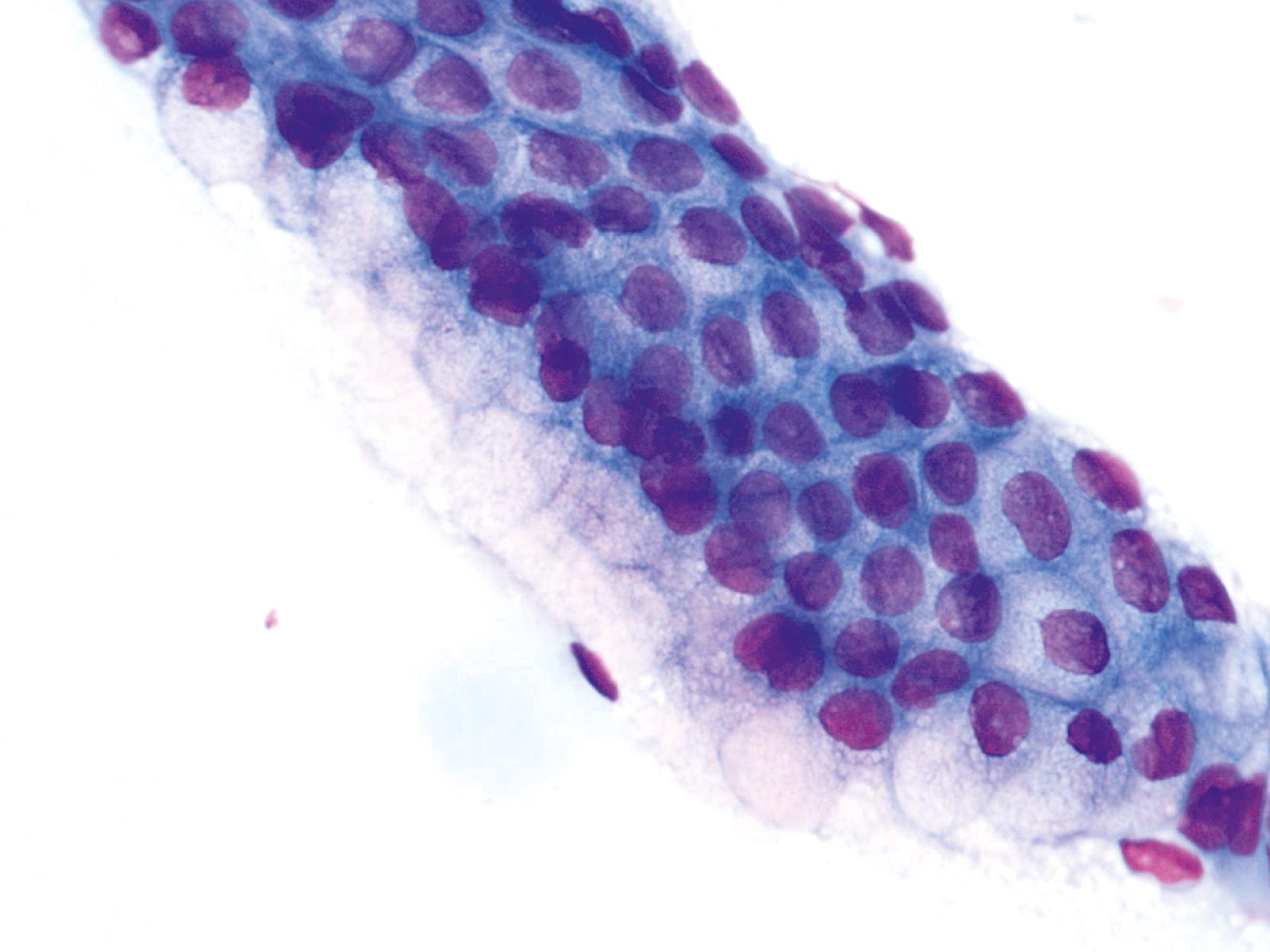
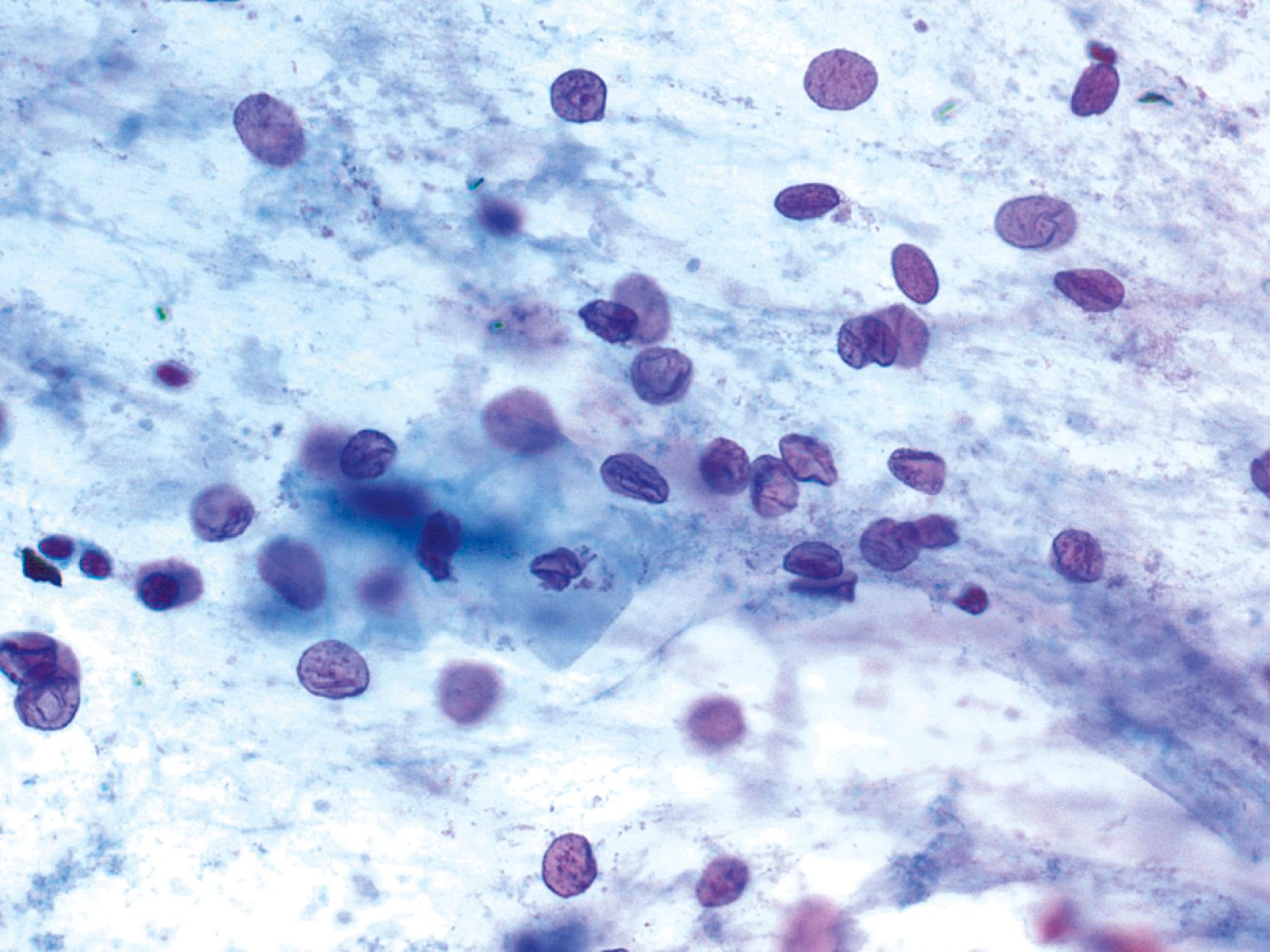
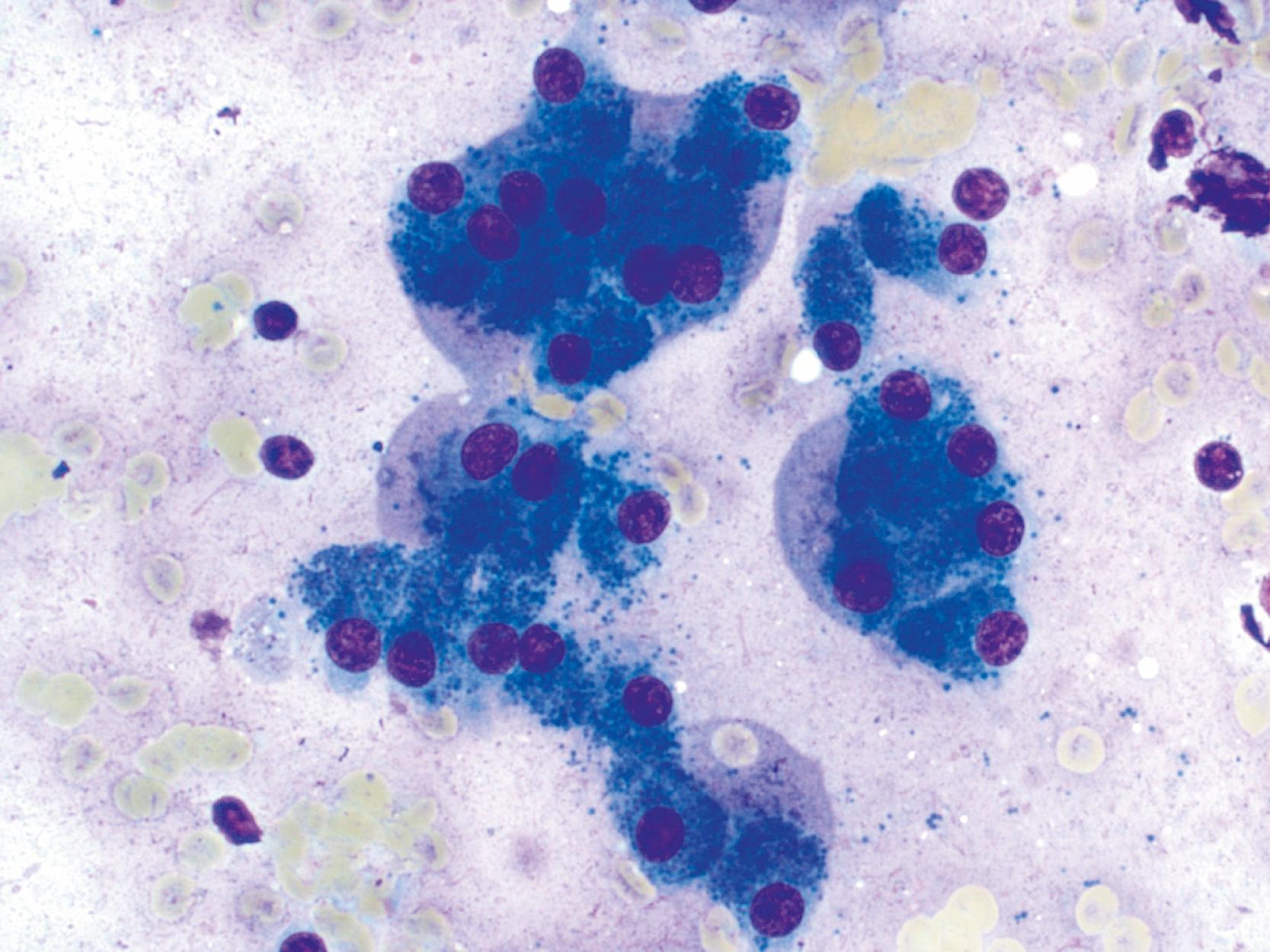
Small intestinal epithelium has a similar architectural appearance to the surface mucous epithelium of the stomach, but the epithelial component is composed of a dual population of absorptive enterocytes with interspersed pale goblet cells and is also associated with background mucin ( Fig. 36.7A ). The brush border is visible when the cells are seen on edge ( Fig. 36.7B ). The epithelium may contain lymphocytes, which appear as darker, small cells within the epithelium. , Paneth cells are occasionally seen and are identified by the presence of coarse eosinophilic granules in the cytoplasm.
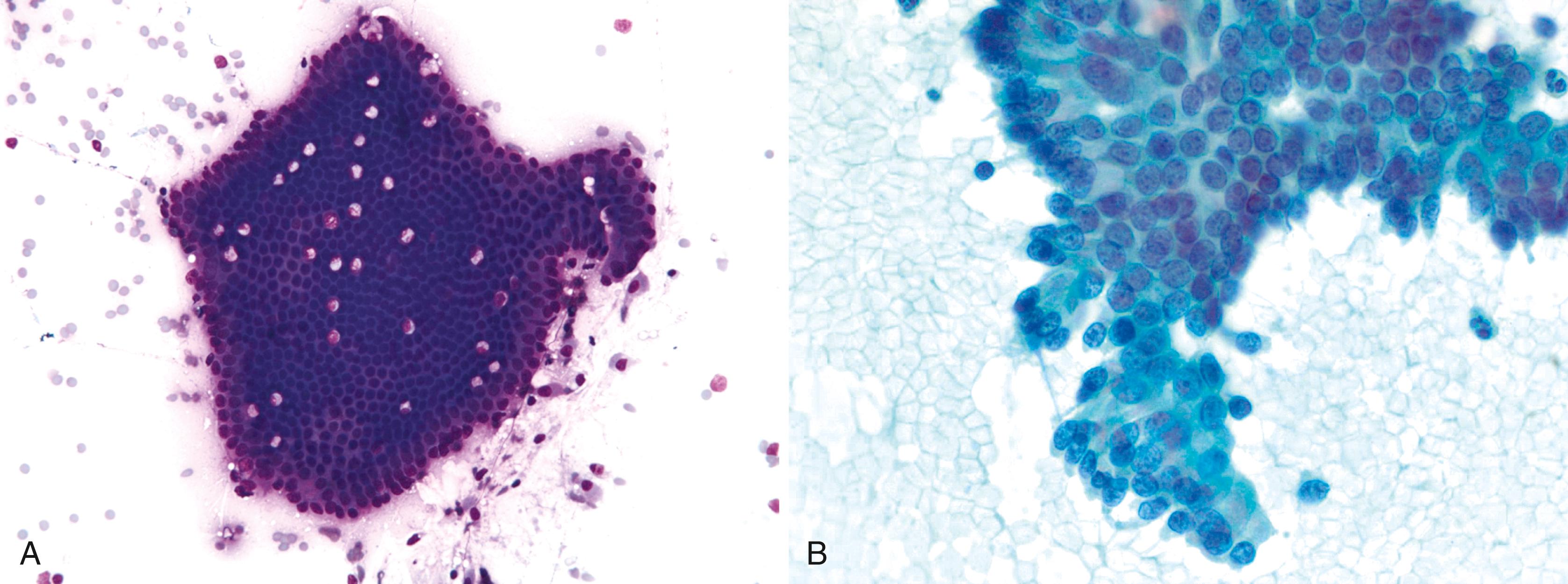
Both the small intestinal epithelium and gastric epithelium may produce abundant degenerated material that should not be confused with neoplastic cells. Both may also be associated with lamina propria that may resemble a stromal neoplasm.
Because brushing cytology is the most frequent technique used to sample the biliary tract, the cytological descriptions in this section pertain to brushing cytology. The cytological criteria for the FNA diagnosis of benign and malignant entities in the biliary tract are similar to those in the pancreas.
Normal bile duct epithelial cells are tall columnar or cuboidal in appearance and are typically arranged in flat monolayer sheets ( Fig. 36.8A ), or in a picket fence arrangement with basally located nuclei ( Fig. 36.8B ). Nuclei are round to oval, and cytoplasmic borders are distinct ( Box 36.5 ).
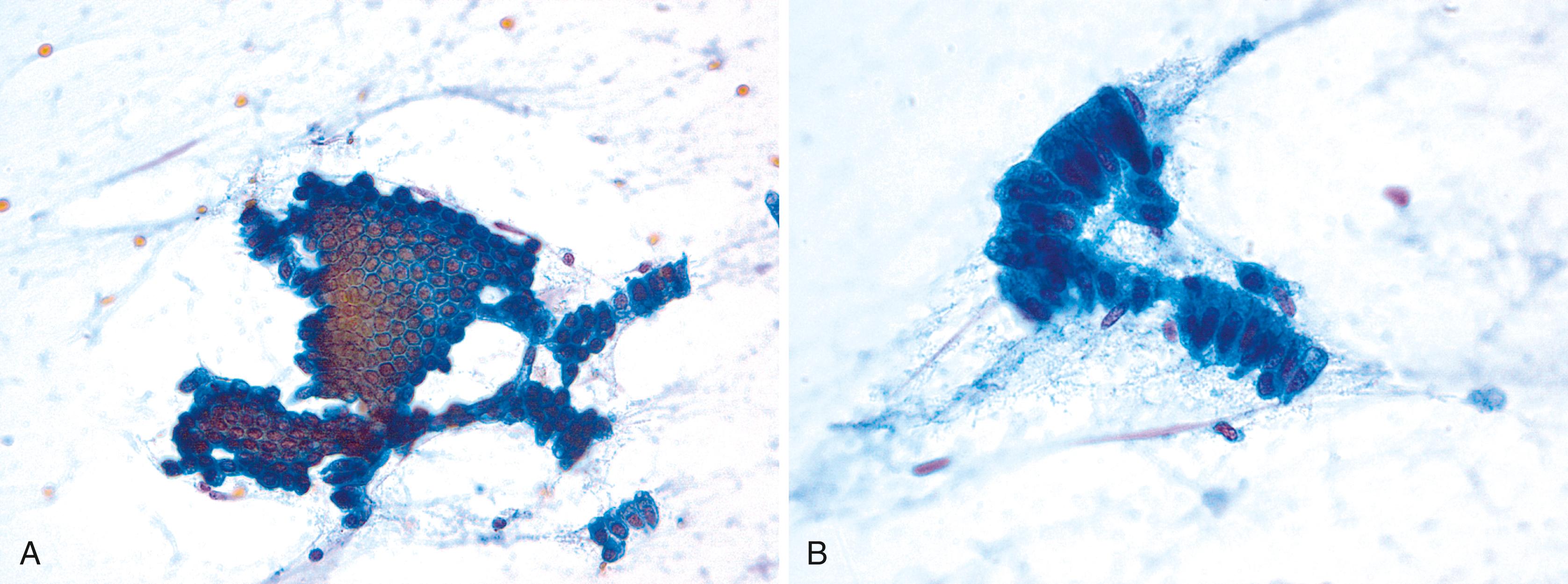
Flat, monolayered, honeycomb sheets or picket fence arrangement with basally located nuclei
Round to oval, uniformly sized and spaced nuclei
Inflammation of the biliary system results from choledocholithiasis, primary sclerosing cholangitis, acute cholangitis, infections, calculi, stents, or instrumentation. The changes induced by inflammation include loss of surface structures, cytoplasmic vacuolization, nuclear enlargement, coarse hyperchromasia, and multinucleation ( Fig. 36.9 ). The epithelium remains monolayered and lacks pseudoacinar structures. Increased numbers of mitoses may be seen but these are normal in appearance. Reactive ductal cells may undergo degeneration including single-cell necrosis with resultant apoptotic and necrotic debris in the smear background. Necrosis alone is therefore insufficient for a diagnosis of malignancy. In inflammation or injury, the epithelial lining may undergo mucinous metaplasia or squamous metaplasia ( Box 36.6 ).
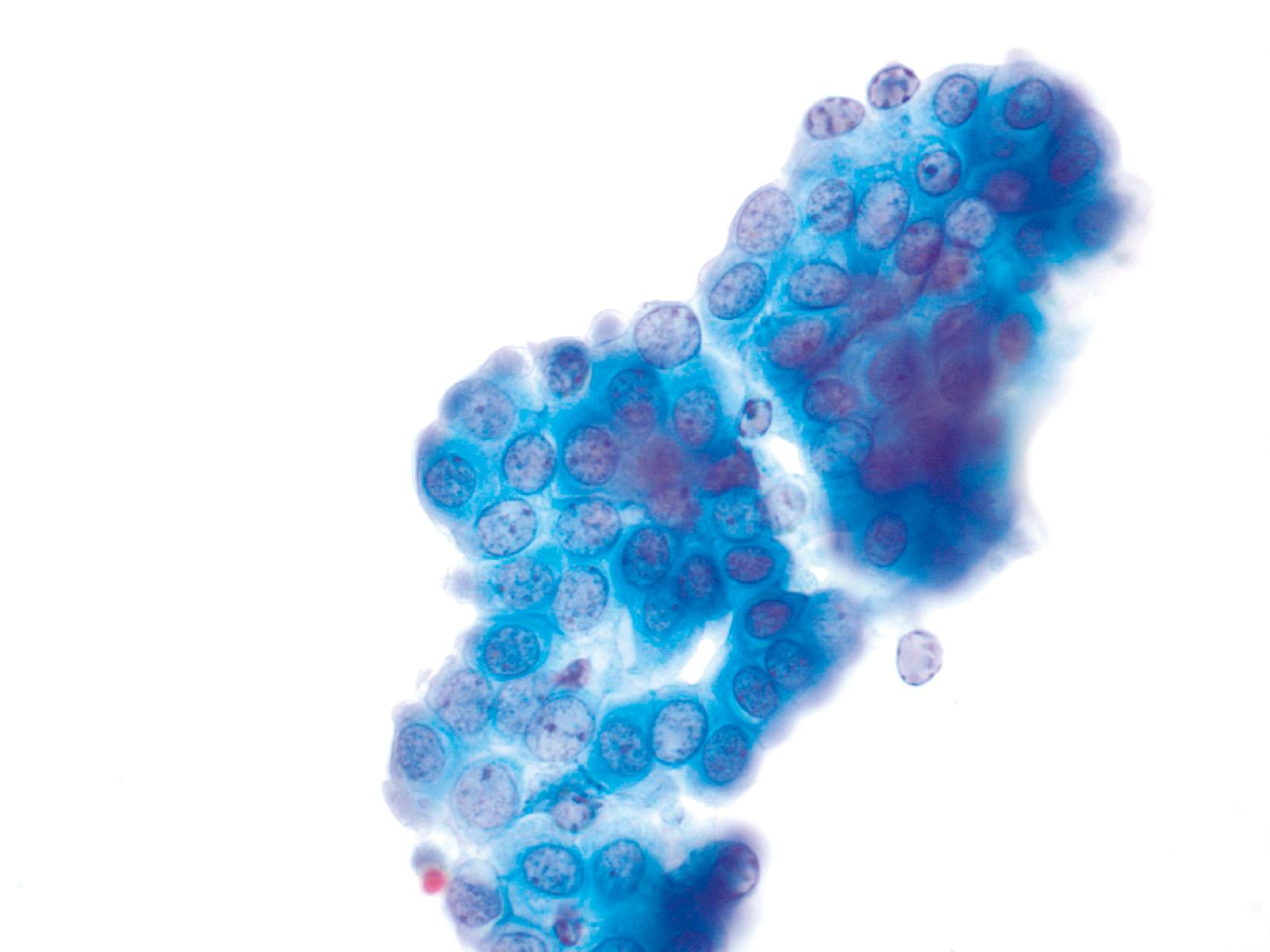
Less orderly groups
Loss of surface structures
Vacuolization of the cytoplasm
Minimal nuclear enlargement and anisonucleosis
Coarse hyperchromasia
Multinucleation
Squamous or mucinous metaplasia
Adenomatous epithelium with low-grade dysplasia appears as slender, elongated columnar cells arranged singly or in small sheets and clusters. The long, thin, basally oriented nuclei occupy about one third of the cell. The chromatin is typically fine and granular with one or more small nucleoli . Brushings from these may be difficult to separate from adenocarcinoma or dysplasia (see Box 36.7 ). Premalignant lesions of the bile ducts have historically been called biliary dysplasia or atypical biliary epithelium. The original 3-tier classification of Biliary Intraepithelial Neoplasia (BilIN) that was published in 2007 has been replaced by a more reproducible 2-tier system of low- and high-grade dysplasia. Low-grade BilIN encompasses BilIN grade 1 and 2, while high-grade BilIN represents severe or grade 3 dysplasia. The diagnostic histopathological criteria are similar to those used for other intraepithelial lesions, but the diagnostic cytopathological criteria for these lesions have not been defined. However, it can be assumed that their cytological features will be similar to what has been described as dysplasia in the biliary tract, with low-grade (grade 1 and 2) lesions causing atypia on bile duct brushings, previously referred to as low-grade dysplasia, and grade 3 lesions causing atypia previously referred to as high-grade dysplasia (grade 3).
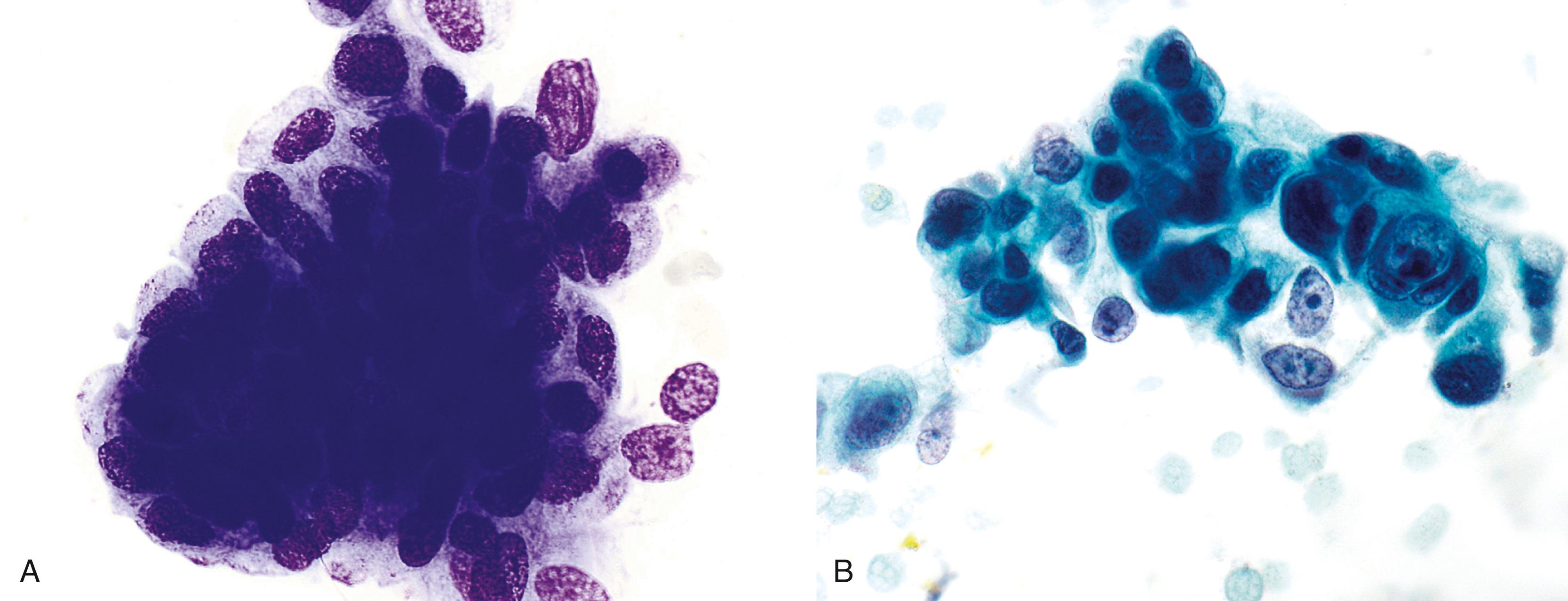
Loosely cohesive sheets, clusters, or single cells
Columnar cells, with elongated, basally located nuclei
Nuclei occupy approximately one-third of the cell
Fine, granular chromatin
Prominent nucleoli
Low-grade dysplasia or BilIN is characterized by sheets and clusters of cells that show nuclear crowding and overlapping, smooth nuclear membranes, and a moderate increase in nuclear-to-cytoplasmic (N/C) ratio ( Fig. 36.10A ). Chromatin is characteristically clear and granular, with mild clumping. Low-grade dysplastic cells may have one or two distinct nucleoli. More pronounced nuclear crowding and overlapping occurs in high-grade dysplasia/BilIN (grade 3). In these cases, nuclear membranes are irregular and the N/C ratio is significantly increased, with coarse or pale chromatin and distinct and/or prominent nucleoli ( Fig. 36.10B ; Box 36.8 ).
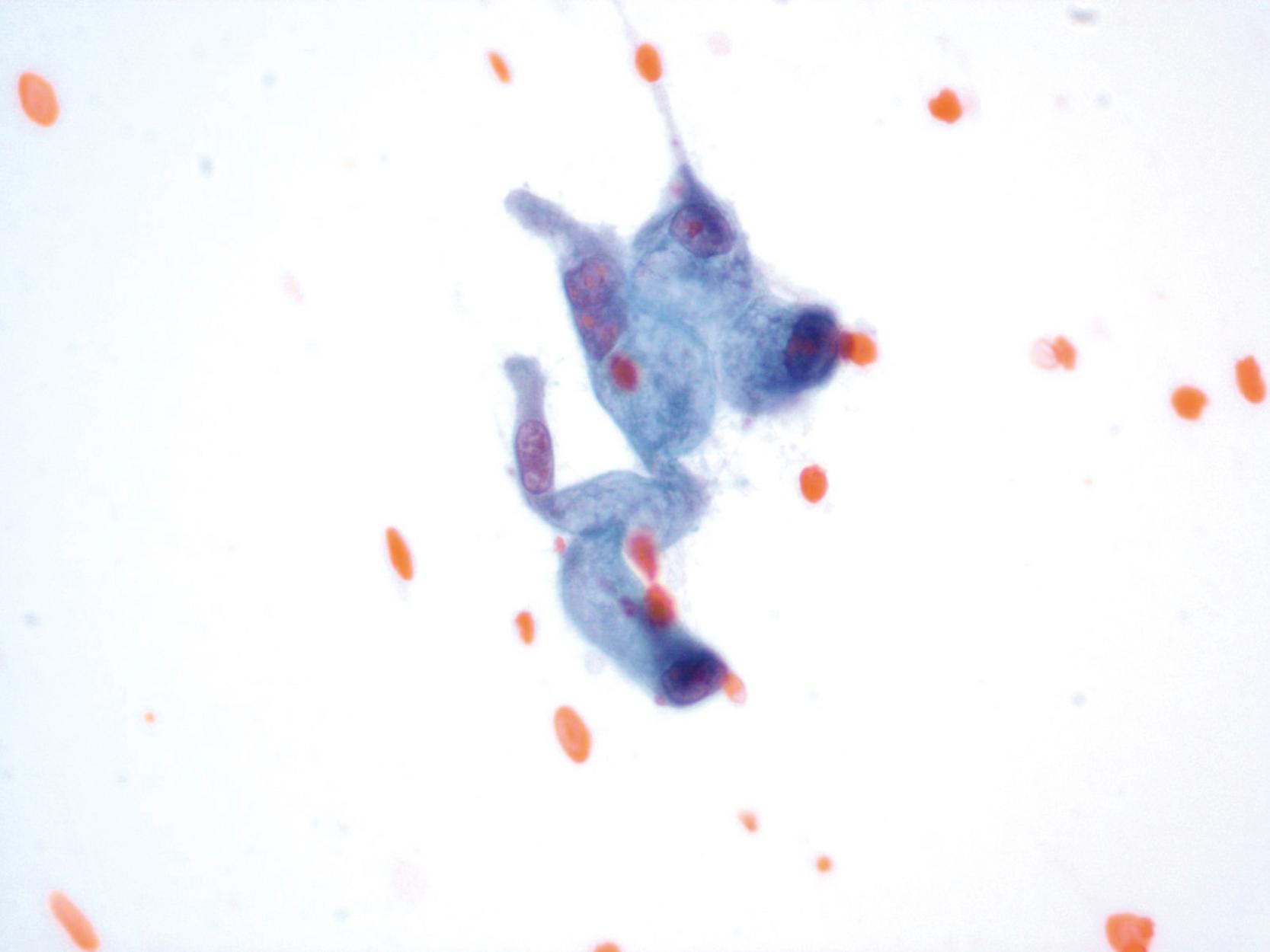
Sheets and clusters with nuclear crowding and overlapping
Smooth nuclear membrane
Moderately increased nuclear-to-cytoplasmic ratio
Minimal nuclear enlargement
Three-dimensional, crowded groups with nuclear overlapping
Nuclear enlargement
Nuclear membrane irregularities
Coarse chromatin
Intraductal papillary neoplasms of the bile ducts (IPN-Bs) correspond to lesions previously referred to as biliary papillomatosis, or cystic or mucinous lesions of the biliary tract, similar to intraductal papillary mucinous neoplasms of the pancreas (IPMN-P). The role of cytology in diagnosing these lesions is not established. What has been previously described as atypical papillary or mucinous cells indicative of well-differentiated adenocarcinoma are probably derived from these lesions. Cytological features of papillary differentiation include cell groups with crowding and overlapping, papillae formation, and elongated nuclei. IPN-B may or may not contain intracytoplasmic mucin depending on their lining epithelium ( Fig. 36.11 ).
Cytology preparations of adenocarcinoma tend to be cellular and contain both cohesive groups and singly dispersed cells. In well-differentiated examples, groups of cells may be arranged in crowded overlapping “drunken honeycomb” sheets with minimal loss of polarity. However, 3-dimensional clusters of markedly atypical cell are more common in poorly differentiated carcinoma. Other characteristics that are frequent in adenocarcinoma include (from greatest to least common) changes in chromatin pattern (both hypochromasia and hyperchromasia), nuclear membrane irregularity, pleomorphism, two-cell populations, high N/C ratio, and cytoplasmic mucin vacuoles ( Figs. 36.12 and 36.13 ). Other nonspecific and less common changes that can be seen in malignancy include dyscohesion of cells with high N/C ratio, specimen hypercellularity, prominent nucleoli, and necrosis. In poorly differentiated or high-grade carcinomas nuclei are less rounded and become rectangular, pointed, or angulated with convolutions and notches and have more prominent nucleoli. Pseudoacinar formations are another feature of adenocarcinoma ( Fig. 36.14 ; Box 36.9 ). Some adenocarcinomas are rich in acute inflammatory cells, which may lead to misinterpretation as representing reactive atypia. Usually in reactive atypia there is no nuclear membrane folding.



Cellular smears
Two-cell populations
Crowded groups of cells with nuclear overlapping and loss of polarity
Dyshesion
Excessive mucinous cytoplasm
Anisonucleosis
Nuclear membrane irregularities
Increased nuclear size
Increased nuclear-to-cytoplasmic ratio
Mucinous and papillary differentiation have been described as subtle findings in well-differentiated adenocarcinoma, and it was once recommended that pathologists report any mucinous change as possibly representative of a mucinous neoplasm, and any papillary change as suggestive of a papillary neoplasm. It now seems that these morphological patterns are derived from IPN-B if identified on a brushing as previously described in this chapter. If these findings are identified on an FNA of a solid mass they are more likely to correlate with an invasive process.
One major pitfall in the interpretation of biliary tract cytology samples is the presence of papillary pattern because normal bile epithelium may form pseudopapillary clusters. Papillary clusters in normal duct cells are 2-dimensional while the cell clusters in true papillary lesions are crowded, and nuclei are haphazardly arranged. The nuclei of true papillary lesions are also more angulated and elongated, in contrast to normal cells, which remain round to oval in shape. Occasionally, the nuclei of benign epithelium may also appear elongated, but again, the architectural arrangement is key. Carcinomas show a greater degree of architectural abnormalities and the presence of hyperchromatic or hypochromatic, transparent nuclei.
Secondary tumors may also involve the biliary tree and lead to positive brushings. These may represent biliary tract extension of nearby nonductal cancers such as hepatocellular carcinoma or gallbladder carcinoma. They also include metastatic neoplasms such as neuroendocrine neoplasms, lymphoma, and metastases from lung, esophageal, and colonic adenocarcinoma. , In patients without a known history of prior malignancy these malignant cells may be misinterpreted as primary pancreatobiliary carcinomas. A high index of suspicion is therefore warranted, along with ancillary studies (immunohistochemistry and flow cytometry) whenever this is suspected.
The key problem when assessing pancreatobiliary brushing cytology specimens is differentiating a reactive process from adenocarcinoma. A number of studies have focused on identifying sets of criteria that are most specific for adenocarcinoma. Initial studies assessing cytological criteria on smears found architectural abnormalities, such as nuclear enlargement, “cell-in-cell” arrangement, loss of polarity, the presence of flat nuclei, nuclear molding, chromatin clumping, as well as a bloody background, as indicative of adenocarcinoma, although a cytologist’s overall gestalt appeared to be just as good. Another description cites adenocarcinoma as showing architectural features of high-grade dysplasia but with more single cells.
In ThinPrep (Cytyc Corporation, Marlborough, MA) prepared specimens; features that were typical of carcinomas were 3-dimensionality (3D), anisonucleosis, high N/C ratio, nuclear contour irregularity, and prominent nucleoli. A recent study showed that the most frequent characteristics that were predictive of carcinoma were 3-dimensional clusters, pleomorphism, 2-cell population, change in chromatin pattern (hypo/hyperchromasia), high N/C ratio, cytoplasmic mucin vacuoles, nuclear irregularity, cellular dyscohesion, hypercellularity, nuclear molding, and prominent nucleoli. Most malignant brushings had ≥3 malignant characteristics, while 77% of benign brushings had none. Cytomorphological features that are not helpful in distinguishing malignant and benign cases are single naked nuclei, inflammation, and necrosis. , , Table 36.2 summarizes these criteria.
| Criterion | Reactive | Adenocarcinoma |
|---|---|---|
| Architecture | Retain honeycomb pattern, 2-dimensionality | Lose honeycomb pattern, 3-dimensionality |
| Loss of polarity | Absent | Present |
| Nuclear molding | Absent | Present |
| Nuclear-to-cytoplasmic ratio | Low | Increased |
| Nuclear membrane irregularities | Minimal | Loss of roundness, nuclei become angulated |
| Anisonucleosis | Minimal | >4:1 |
| Nuclear enlargement | Absent to minimal | Present |
| Chromatin | Finely dispersed | Coarse or hypochromatic |
| Cell population | Range of atypia | Two-cell population |
| Single, malignant cells | Absent | Present |
A number of technologies have been applied to indeterminate bile duct cytology specimens to improve sensitivity and specificity. The ancillary techniques employed include next-generation sequencing (NGS), fluorescent in situ hybridization (FISH), protein analysis, and immunocytochemistry.
NGS was recently used to identify driver gene mutations in 30% of bile duct brushings, including mutations in KRAS (88%), TP53 (58%), SMAD4 (25%), and CDKN2A (17%).
Initial studies showed that both digital image analysis (DIA) and FISH improved the sensitivity of brushing cytology in the diagnosis of adenocarcinoma in pancreatobiliary strictures. The UroVysion FISH panel that was developed to detect urothelial carcinoma and consists of 4 probes directed against chromosomes 3, 7, 9p21, and 17 increases the sensitivity of routine cytology in detecting carcinoma, , In another study, UroVysion FISH had a sensitivity of 94% compared with a sensitivity of 81% using routine cytomorphology. Combining NGS for KRAS mutation with FISH analysis increases cancer detection rates in pancreatobiliary strictures beyond that of cytology and FISH alone. KRAS mutations and positive FISH results were identified in 69% and 63% of pancreatic adenocarcinoma specimens, respectively, with a combined sensitivity of 86%. KRAS mutations and polysomic FISH results were identified in fewer cholangiocarcinoma cases (29% and 41%, respectively) and had a combined sensitivity of 54%. In an analysis of 81 brushings, where cytology had a sensitivity of 67% (95% CI, 48% to 82%) and a specificity of 98% (95% CI, 89% to 100%), NGS and UroVysion FISH both increased test sensitivity (85% [95% CI, 68% to 95%] and 76% [95% CI, 58% to 89%], respectively).
More recently, a pancreatobiliary-specific FISH probe set (PB-FISH) was created specifically for detection of cholangiocarcinoma and pancreatic ductal adenocarcinoma. PB-FISH had a higher sensitivity than UroVysion FISH for detecting cancer on brushings (65% vs 46%; P < 0.001) and cytology (19%; P < 0.01) but had a specificity (93%) that was similar to both (UroVysion, 91%; cytology, 100%). The PB-FISH probes identify polysomy of multiple oncogenes ( MCL1 on chromosome 1q, EGFR on chromosome 7p, and MYC on chromosome 8q) and deletion of p16/ CDKN2A tumor suppressor gene on the 9p21 locus.
Some proteins reportedly increase sensitivity of brushing cytology for the detection of adenocarcinoma. Insulin-like growth factor mRNA-binding-protein-3 (IMP3 cytology), when used alone, showed a sensitivity of 64.1% for the diagnosis of adenocarcinoma and 74.1% when combined with cytology, while cytology alone showed a sensitivity of 33.3%. S100P is upregulated in cholangiocarcinoma. Analysis of S100P expression using reverse transcription-polymerase chain reaction (RT-PCR) showed that this protein was frequently expressed in adenocarcinomas of the biliary tract but not in normal tissues. Tumor cells of cholangiocarcinoma show loss of von Hippel-Lindau protein (pVHL) and are positive for S100P, IMP3, and monoclonal CEA immunostains, whereas reactive biliary epithelium shows opposite results.
Become a Clinical Tree membership for Full access and enjoy Unlimited articles
If you are a member. Log in here